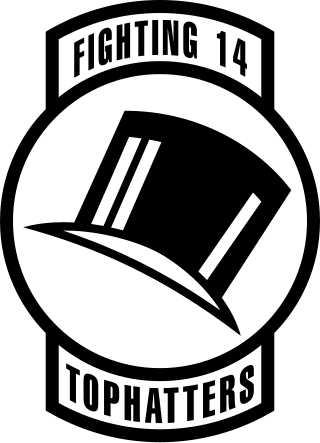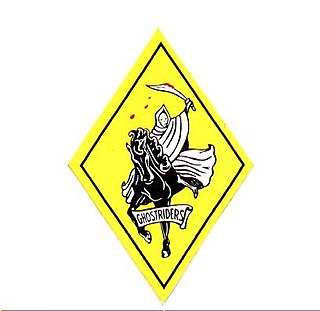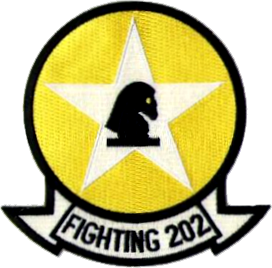
Strike Fighter Squadron 211 (VFA-211), nicknamed the "Fighting Checkmates", is an aviation unit of the United States Navy established in 1945. The squadron is based at Naval Air Station Oceana and is equipped with the Boeing F/A-18E Super Hornet.

The Strike Fighter Squadron 14 (VFA-14) "Tophatters" are a United States Navy fighter attack squadron based at Naval Air Station Lemoore. They fly the F/A-18E Super Hornet, and are the Navy's oldest active squadron, having formed in 1919. Their callsign is Camelot, and their tail code is NG.

VFA-31 or Strike Fighter Squadron 31 is known as the Tomcatters, callsign "Felix", a United States Navy strike fighter squadron stationed at Naval Air Station Oceana flying the F/A-18E Super Hornet. The Tomcatters are the second oldest Navy Fighter Attack squadron operating today.

Strike Fighter Squadron 213 (VFA-213) Blacklions is an aviation unit of the United States Navy based at Naval Air Station Oceana, Virginia. It was established in 1955 and is currently equipped with the F/A-18F Super Hornet. The squadron is assigned to Carrier Air Wing Eight and uses the radio callsign Lion.

Strike Fighter Squadron 102 (VFA-102) is a United States Navy Strike Fighter squadron based at Marine Corps Air Station Iwakuni. Their call sign is Diamond, with the tail code NF, and they fly the F/A-18F Super Hornet.

The VFA-201, Strike Fighter Squadron was an aviation unit of the United States Naval Reserve based at Naval Air Station Joint Reserve Base Fort Worth, Texas (USA). It was established in 1970 as part of Reserve Carrier Air Wing 20 (CVWR-20) and deactivated in 2007. During its service VFA-201 could be identified by the tail code "AF" and nose numbers (MODEX) in the "100" series, typically 100 to 113. The squadron's nickname was the Hunters.

William Patrick "Willy Irish" Driscoll is a retired commander in the United States Navy and a flying ace. Driscoll, a Naval Flight Officer, and aircrewmate Duke Cunningham, a Naval Aviator, were their service's only aces of the Vietnam War. They remain the Navy's most recently minted aces.

Strike Fighter Squadron 2 (VFA-2) also known as the "Bounty Hunters" is a United States Navy F/A-18F Super Hornet strike fighter squadron based at Naval Air Station Lemoore, California. Their tail code is NE and their callsign is "Bullet". They are attached to Carrier Air Wing 2 (CVW-2), a composite unit made up of a wide array of aircraft performing a variety of combat and support missions that deploy aboard the Carl Vinson.

Strike Fighter Squadron 11 (VFA-11) is a United States Navy strike fighter squadron stationed at Naval Air Station Oceana, Virginia, United States. The squadron was established in 1950 and is nicknamed "Red Rippers". VFA-11 is equipped with the Boeing F/A-18F Super Hornet and currently assigned to Carrier Air Wing One.

Fighter Squadron 24 (VF-24), called the Fighting Renegades was a fighter squadron of the United States Navy. Originally established as Fighter Squadron 211 in June 1955, it was redesignated VF-24 on 9 March 1959 and disestablished on 31 August 1996.

Strike Fighter Squadron 101 (VFA-101), also known as the "Grim Reapers", was a United States Navy Fleet Replacement Squadron (FRS) based at Eglin AFB, Florida. After the West Coast FRS for the F-14 Tomcat, VF-124, was disestablished in the mid-1990s, VF-101 became the sole F-14 FRS. At the time it was based at NAS Oceana in Virginia. With the retirement of the F-14, VF-101 was deactivated in 2005. It was reactivated in 2012 and redesignated Strike Fighter Squadron 101 (VFA-101). It was one of two F-35C Lightning II FRS before being deactivated in 2019. It was based at Eglin AFB, Florida with the joint 33d Fighter Wing, as a subordinate unit of the U.S. Navy's Strike Fighter Wing, U.S. Pacific Fleet.

Fighter Squadron 124 or VF-124Gunfighters was a fleet replacement squadron (FRS) of the United States Navy. Originally established on 16 August 1948 as VF-53, it was redesignated VF-124 at NAS Moffett Field on 11 April 1958 due to a need for an increased number of flight training squadrons, itself necessary because of introduction of swept wing fighters into Navy service. In 1961, the squadron relocated to NAS Miramar, California, which would become the U.S. Pacific Fleet's Master Jet Base for fighter aircraft.

VF-142 Ghostriders was a US Navy fighter squadron established on 24 August 1948 as VF-193, it was redesignated VF-142 on 15 October 1963, and disestablished on 30 April 1995.

Strike Fighter Squadron 143 (VFA-143), also known as the "Pukin Dogs," is a United States Navy strike fighter squadron based at Naval Air Station Oceana, Virginia. The Pukin Dogs are an operational fleet squadron and flying the F/A-18E Super Hornet. They are currently attached to Carrier Air Wing Seven and USS George HW Bush. They are currently at their homeport of NAS Oceana. Their radio callsign is Taproom.

Fighter Squadron 202 (VF-202) nicknamed the Superheats was an aviation unit of the United States Naval Reserve initially based at Naval Air Station Dallas, Texas. Following that installation's BRAC-directed closure, the squadron relocated to nearby former Carswell Air Force Base, which was transferred to U.S. Navy control according to BRAC action and renamed Naval Air Station Joint Reserve Base Fort Worth / Carswell Field. VF-202 was established on 1 July 1970 as part of Reserve Carrier Air Wing 20 (CVWR-20), the U.S. Atlantic Fleet's reserve carrier air wing, and disestablished on 31 December 1994. During its service VF-202 could be identified by the tail code "AF" and nose numbers (MODEX) "200" through "213."

Fighter Squadron 302 (VF-302) was an aviation unit of the United States Naval Reserve in service from 1971 to 1994. The squadron's nickname was Stallions.

Fighter Squadron Composite 111 (VFC-111), also known as the "Sun Downers", is a United States Navy Reserve adversary squadron based at Naval Air Station Key West, Florida. Currently, it operates Northrop F-5N/F Tiger-IIs, of which most are single-seater F-5Ns and one twin-seater F-5F, the "FrankenTiger".

Fighter Squadron Composite 204 (VFC-204), also known as the "River Rattlers", is a United States Navy Reserve adversary squadron, slated to fly the F-5N/F Tiger II after having previously flown the F/A-18C/D Hornet. The squadron is based out of Naval Air Station Joint Reserve Base New Orleans, Louisiana, and is part of the U.S. Navy Reserve's Tactical Support Wing. Their radio callsign is "River" and their tail code is "AF".

Fighter Squadron 194 or VF-194 was a short-lived aviation unit of the United States Navy established on 1 December 1986 and disestablished on 30 April 1988. It was the fourth US Navy squadron to be designated VF-194.























